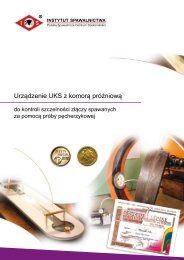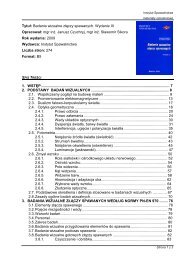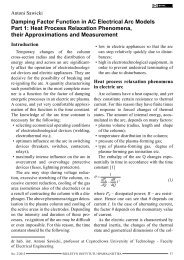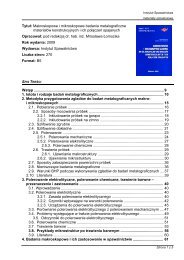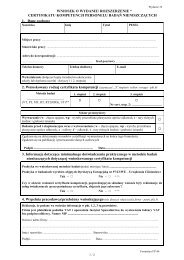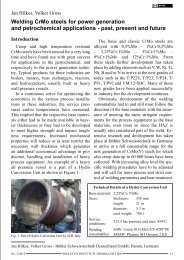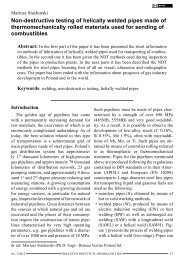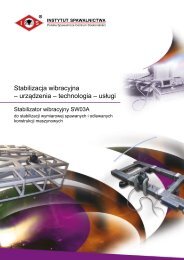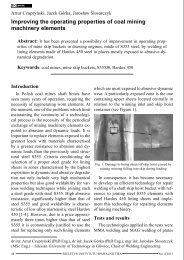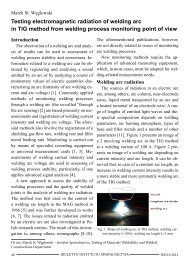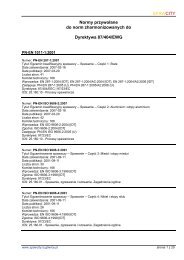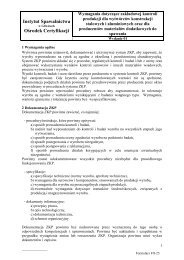Biuletyn Instytutu Spawalnictwa No. 01/2012
Biuletyn Instytutu Spawalnictwa No. 01/2012
Biuletyn Instytutu Spawalnictwa No. 01/2012
You also want an ePaper? Increase the reach of your titles
YUMPU automatically turns print PDFs into web optimized ePapers that Google loves.
Fig. 13. Macrostructure of T-shaped joint, made of 2.0mm<br />
-thick steel H389 LAD Z140; joint welded with 0.5 mm<br />
gap; etchant: Adler, magnification x5<br />
Summary<br />
Conducted technological tests of the welding<br />
of thin plates made of unalloyed and low-alloy<br />
steels of increased strength and protected with<br />
various zinc-based coatings revealed that the<br />
application of variable polarity current makes<br />
it possible to build up joints characterised by<br />
good quality and aesthetics. A process of welding<br />
with variable polarity current is less stable<br />
than traditional MAG welding and emits specific<br />
sounds, yet joints welded in such a process<br />
are characterised by good quality and tend to<br />
be free from spatters.<br />
The basic process variables having the greatest<br />
impact on the course of the process as well<br />
as on the weldability, quality, and aesthetics of<br />
joints are the technological parameters (filler<br />
wire feeding rate, welding rate, torch inclination<br />
angle and arc length) and EN ratio in the<br />
course of welding current. A change of EN ratio<br />
significantly affects arc voltage and the amount<br />
of heat supplied to a joint. Research results revealed<br />
that the best results are achieved with<br />
neutral settings of the parameter. An increase<br />
in EN ratio reduces the penetration depth<br />
and bridging ability of an arc. If one needs to<br />
weld thin plates and avoid, as much as possible,<br />
damage to the zinc coating, a higher EN<br />
ratio should be applied in the course of current.<br />
The application of high EN ratio in the course<br />
of current also makes it possible to weld inaccurately<br />
matched joints. A decreased EN ratio<br />
increases heat input of the process and reduces<br />
the depth of penetration. T-shaped joints and<br />
thicker elements require a higher EN ratio in<br />
the course of current. The most convenient solution<br />
consists in applying a neutral EN ratio,<br />
as such an approach enables obtaining good<br />
quality welds and sufficient penetration depth.<br />
References<br />
1. Matusiak J., Pfeifer T., Wyciślik J., Kiszka<br />
A.: Analiza wpływu warunków technologicznych<br />
innowacyjnych technik spajania<br />
różnych materiałów konstrukcyjnych z nowoczesnymi<br />
powłokami ochronnymi na stan środowiska<br />
pracy. Praca badawcza <strong>Instytutu</strong> <strong>Spawalnictwa</strong><br />
nr Ma-34, Gliwice 2<strong>01</strong>1 r.<br />
2. PN-EN ISO 14341:2<strong>01</strong>1 „Materiały dodatkowe<br />
do spawania. Druty elektrodowe i stopiwo<br />
do spawania łukowego elektrodą metalową<br />
w osłonie gazu stali niestopowych<br />
i drobnoziarnistych. Klasyfikacja”<br />
3. PN-EN ISO 14175:2009 „Materiały dodatkowe<br />
do spawania. Gazy i mieszaniny gazów<br />
do spawania i procesów pokrewnych”<br />
4. PN-EN 10346:2<strong>01</strong>1 „Wyroby płaskie<br />
stalowe powlekane ogniowo w sposób ciągły.<br />
Warunki techniczne dostawy”<br />
5. PN-EN 1<strong>01</strong>52:2<strong>01</strong>1 „Wyroby płaskie<br />
stalowe walcowane na zimno ocynkowane<br />
elektrolitycznie do obróbki plastycznej na<br />
zimno. Warunki techniczne dostawy”<br />
6. Szubert L., Skoczewski P, Welcel M.:<br />
System rejestracji parametrów elektrycznych<br />
procesu spawania dla wielu stanowisk produkcyjnych.<br />
Praca badawcza <strong>Instytutu</strong> <strong>Spawalnictwa</strong><br />
nr Fc-89, Gliwice 2<strong>01</strong>0 r.<br />
7. Jaskólski K.: Robotyzacja OTC z wykorzystaniem<br />
niskoenergetycznych metod spawania.<br />
Materiały firmy SAP, 2<strong>01</strong>0<br />
8. PN-EN ISO 5817:2009 „Spawanie. Złącza<br />
spawane ze stali, niklu, tytanu i ich stopów<br />
(z wyjątkiem spawanych wiązką). Poziomy<br />
jakości według niezgodności spawalniczych”<br />
NR <strong>01</strong>/2<strong>01</strong>2<br />
BIULETYN INSTYTUTU SPAWALNICTWA<br />
39



